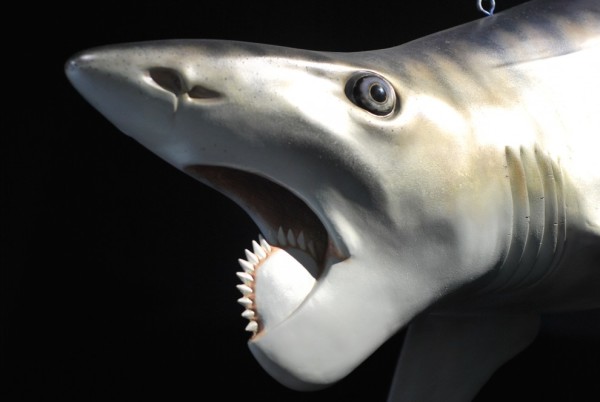When I think of Idaho, ratfish are not what immediately come to mind. Spuds and the ghastly belt of agricultural reek that keeps me holding my breath whenever I speed past Idaho Falls on the interstate, sure, but not strange cartilaginous fish. A new exhibit at the the Idaho Museum of Natural History is aiming to change that.
Over 270 million years ago, the area that eventually would be called Pocatello, Idaho was an ancient sea that hosted an exceptionally enigmatic fish whose mystery has only just started to truly unravel. These archaic ratfish are known almost entirely from their jaws – whorls of teardrop-shaped teeth first described from finds in Russia, but later discovered in abundance among the spoil piles of eastern Idaho’s phosphate mines. Experts knew these spirals by the name Helicoprion, and there were seemingly as many opinions about what these toothy coils were as paleontologists who studied them.
Virtually everyone agreed that the fossils were part of some sort of ancient fish. Where the whorls fit on those fish, however, was a matter of constant contention. Some placed the spiky circles on the backs or tails of ancient sharks, while others believed that the peculiar structures must have been part of the jaw. Even within this latter hypothesis, paleontologists disagreed over whether the spirals freely hung below the jaw, were enclosed within the mandible, or had a matching set of upper teeth. With only a swirl of teeth to work with, the rest of the animal was a blank that paleontologists could restore in almost any way they chose.
A gallery of Helicoprion hypotheses. Artwork © Ray Troll 2013.
But, as displayed in the new Idaho Museum of Natural History exhibit, we now have a much clearer idea of who Helicoprion actually was. Thanks to the persistent questions of student Jesse Pruitt, the technical expertise of paleontologist Leif Tapanila and colleagues, and, most of all, the obsession of artist Ray Troll, the whorl-toothed “shark” has turned out to be a sleek, buzzsaw-jawed ratfish that sliced through ancient cephalopods with a single blade of enamel-covered spikes.
Preserved remnants of cartilage – long-known, but only recently seen through high-resolution imagery – was the key to finally restoring Helicoprion. The fragments revealed enough of the skull to show how the teeth sat in the jaw and, unexpectedly, brought the fish into a closer relationship with ratfish than with sharks, as had traditionally been thought. (Helicoprion is still often referred to as a shark, though. To bastardize a classic movie line: “You yell ‘ratfish’, people say ‘Huh? What?’ You say ‘shark’, you’ve got a hit exhibit.”) The resulting image is an alien creature – the familiar fusiform, shark-like body with a bizarre, bug-eyed head sporting those characteristic teeth.
The Idaho museum’s exhibit inundates visitors with this new imagery from the second they step foot into the shadowy hall. Alongside displays of actual Helicoprion jaws – including the very specimen that solved the Permian puzzle – gorgeously-detailed artistic depictions of the ratfish by Troll hang from wallpaper also designed by the fossil’s biggest fan. Sculpted versions of Helicoprion by artist Gary Staab and a working set of Helicoprion jaws bring the fish to life in a way never seen before, and the brief tour ends in a little lounge complete with a couch specially-upholstered in tooth whorl fabric. When I spoke to Pruitt, Tapanila, and Troll at the exhibit’s opening, I begged them to make the line of Helicoprion home furnishings available for purchase to fellow paleo nerds.
A new look for the ratfish relative Helicoprion. Artwork © Ray Troll 2013.
Thanks to the artistic abilities of Staab and Troll (who has been chasing in the wake of the whorl-tooth for decades), the Helicoprion exhibit is totally entrancing. Walking through the exhibit feels like a stroll through Troll’s mind, complete with the lighthearted weirdness that makes his artwork so wonderful. On a portrait of a scissor-toothed fish known as Edestus giganteus, for one, Troll paired his scientifically-rigorous restoration with lines such as “‘Ed’ the Shred Head”, “The Ripper!”, and “Slice and dice, I’d say” scrawled onto the illustration. And if you visit the displays, try to count all the cheeseburgers hidden within the art and exhibits.
The joy of the Helicoprion celebration is in the visuals. This isn’t to say that the displays shy away from science, but rather that the accompanying text is minimal and to-the-point. That’s a good thing. The approach allows visitors to engage with the displays at whatever level they desire. You can walk through the hall and simply enjoy Troll’s odes to Helicoprion, or you can dig into some details of strange fish called eugeneodontids – the varied family of Helicroprion that included scissor, whorl, and pavement-toothed monstrosities, including a nightmarish form called Edestus newtoni, with spiky, outward-curving jaws that look as if they’re sinisterly inviting prey for a deadly kiss.
The techniques that Pruitt, Tapanila, Troll, and collaborators used to envision Helicoprion will help reveal the nature of some of these other weird fish. But Helicoprion will always be the star in the family. Few petrified puzzles have been more famous, and the Idaho Museum of Natural History exhibit is a loving tribute to Helicoprion created by those who have found their imaginations permanently snagged on those spiral jaws.





Leave a reply